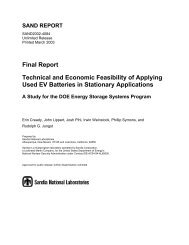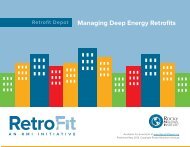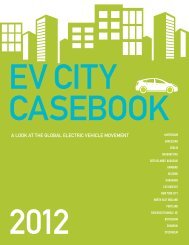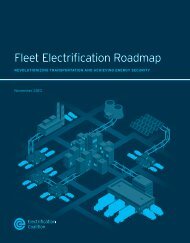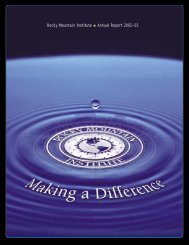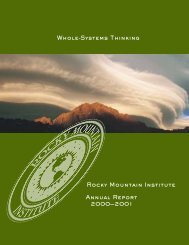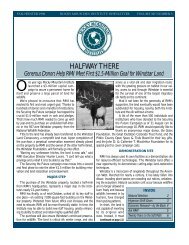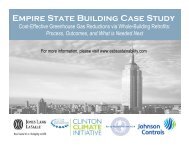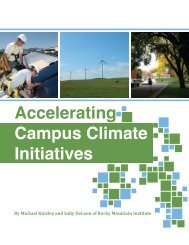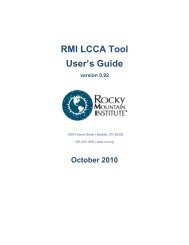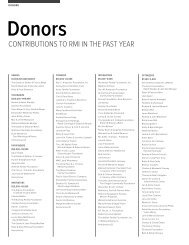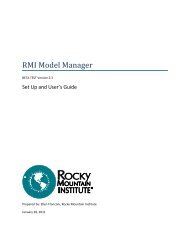Abundance by Design - Rocky Mountain Institute
Abundance by Design - Rocky Mountain Institute
Abundance by Design - Rocky Mountain Institute
- No tags were found...
You also want an ePaper? Increase the reach of your titles
YUMPU automatically turns print PDFs into web optimized ePapers that Google loves.
ing their persistent inefficiencies. But <strong>by</strong> setting highgoals for saving capital and resources, TI officialsforced a new level of creativity. With RMI’s help, TI’sfab designers were able to cut total capital cost <strong>by</strong> 30percent, water use <strong>by</strong> 35 percent, and energy use <strong>by</strong>20 percent. The new fab broke ground in November2004 in Richardson, Tex., not in China, because itbecame cheaper to build in the United States. It’salready the talk of the industry. In February 2005,leading semiconductor toolmaker Applied Materialssent RMI’s CEO to keynoteShanghai’s SEMICON conference tosummarize these design innovations,intensify competition, andbring it back to Texas to improvethe next TI fab—which is expectedto save far more energy, yet costeven less to build.• Working with two of theworld’s largest mining companies to bring new levelsof energy, resource, and capital efficiency to preciousmetals,coal, diamond, and other projects. RMIhelped Anglo American identify opportunities tosignificantly improve energy intensity and operationaleffectiveness. For example, in AngloPlatinum alone, the annual savings could amount tothousands of gigawatt-hours and millions of tonnesof carbon dioxide credits <strong>by</strong> 2010. That potential,with associated operational and ergonomic improvements,is now being implemented with strong managementsupport. At another Anglo project, theMondi Richard’s Bay pulp and paper mill, RMI’sanalysis showed how energy efficiency and better useof waste products could lower costs and improveenvironmental quality.• Closely advising a large retailer on advancedefficiency opportunities in buildings and transportation,advising Unilever on the efficiency of its flagshipBen & Jerry’s ice-cream plant in Holland, andhelping a leading European shipyard to develop aradically more efficient and higher-performancedesign with important implications for the wholefield of naval architecture.• Building on our previous year’s work <strong>by</strong> collaboratingwith Cuyahoga County, Entrepreneurs forSustainability (our local cousin), and three foundations(Joyce, Cleveland, and George Gund) toexplore ways to craft a Model for RegenerativeDevelopment of the Cuyahoga River Valley. This synthesiswill bring attention, excitement, and investmentto a gritty industrial area near downtownCleveland that has been ignored for decades. Inrecent years, community leaders have becomeinterested in integrating nature into the bleakbrownfield site. RMI is combining such goals asrestoring wetlands and native vegetation, daylightingtributaries, expanding foot and bikepaths and pocket parks, applying green real-estatedevelopment principles, exploring renewable energysources and systems, and devising wider solutions tostormwater pollution and the stagnant river channel.• Collaborating with the Society forOrganizational Learning on its ongoing MaterialsPooling Project. Some manufacturers pool their purchasingpower to bring nontoxic, recyclable, or otherwisepreferable materials to market. This requiressharing information, articulating definitions of suchfuzzy concepts as “toxins” and “waste,” and nurturingnew intercompany relationships. This project, whichhas a major educational component, includes some ofthe world’s best-known companies, and it is expectedto lead to fruitful new relationships.• Supported <strong>by</strong> the Concordia Foundation andin association with the Sustainability <strong>Institute</strong>,building a nearly-complete System Dynamics modelingtool for exploring how electric utilities’ and societies’choices affect carbon emissions. The tool chartsand mathematically models linkages, then simulatescomplex system behaviors through a user-friendly“management flight simulator.” You can plug incarbon dioxide restrictions and various mixes ofenergy sources and savings, then see how prices,availability, reliability, and other parameters willunfold for the next year or the next twenty. Thisshould greatly help utilities (pp. 6–7) to plan andimplement their energy-related investments tooptimize both carbon and financial performance.<strong>Rocky</strong> <strong>Mountain</strong> <strong>Institute</strong> Annual Report: 2004–059



